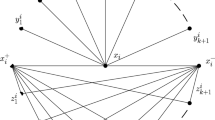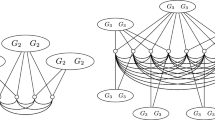Abstract
For a given graph \(G\) with distinct vertices \(s\) and \(t\), nonnegative integral cost and delay on edges, and positive integral bound \(C\) and \(D\) on cost and delay respectively, the \(k\) bi-constraint path (\(k\)BCP) problem is to compute \(k\) disjoint \(st\)-paths subject to \(C\) and \(D\). This problem is known to be NP-hard, even when \(k=1\) (Garey and Johnson, Computers and Intractability, 1979). This paper first gives a simple approximation algorithm with factor-\((2,2)\), i.e. the algorithm computes a solution with delay and cost bounded by \(2*D\) and \(2*C\) respectively. Later, a novel improved approximation algorithm with ratio \((1+\beta ,\,\max \{2,\,1+\ln (1/\beta )\})\) is developed by constructing interesting auxiliary graphs and employing the cycle cancellation method. As a consequence, we can obtain a factor-\((1.369,\,2)\) approximation algorithm immediately and a factor-\((1.567,\,1.567)\) algorithm by slightly modifying the algorithm. Besides, when \(\beta =0\), the algorithm is shown to be with ratio \((1,\, O(\ln n))\), i.e. it is an algorithm with only a single factor ratio \(O(\ln n)\) on cost. To the best of our knowledge, this is the first non-trivial approximation algorithm that strictly obeys the delay constraint for the \(k\)BCP problem.

Similar content being viewed by others
References
Ahuja RK, Magnanti TL, Orlin JB (1993) Network flows: theory, algorithms, and applications. Prentice Hall, Upper Saddle River
Bhatia R, Kodialam M, Lakshman TV (2006) Finding disjoint paths with related path costs. J Comb Optim 12(1):83–96
Chao P, Hong S (2007) A new approximation algorithm for computing 2-restricted disjoint paths. IEICE Trans Inf Syst 90(2):465–472
Garey MR, Johnson DS (1979) Computers and intractability. Freeman, San Francisco
Guo L, Shen H (2012) On the complexity of the edge-disjoint min-min problem in planar digraphs. Theor Comput Sci 432:58–63
Guo L, Shen H (2013) On finding min–min disjoint paths. Algorithmica 66(3):641–653
Guo L, Shen H (2012) Efficient approximation algorithms for computing k disjoint minimum cost paths with delay constraint. In PDCAT, IEEE, p 627–631
Li CL, McCormick TS, Simich-Levi D (1989) The complexity of finding two disjoint paths with min–max objective function. Discret Appl Math 26(1):105–115
Lorenz DH, Raz D (2001) A simple efficient approximation scheme for the restricted shortest path problem. Oper Res Lett 28(5):213–219
Orda A, Sprintson A (2004) Efficient algorithms for computing disjoint QoS paths. In IEEE INFOCOM, Citeseer, vol 1, p 727–738
Suurballe JW (1974) Disjoint paths in a network. Networks 4(2):125
Suurballe JW, Tarjan RE (1984) A quick method for finding shortest pairs of disjoint paths. Networks 14(2):325
Xu D, Chen Y, Xiong Y, Qiao C, He X (2006) On the complexity of and algorithms for finding the shortest path with a disjoint counterpart. IEEE/ACM Trans Netw 14(1):147–158
Xue G, Zhang W, Tang J, Thulasiraman K (2008) Polynomial time approximation algorithms for multi-constrained qos routing. IEEE/ACM Trans Netw 16(3):656–669
Author information
Authors and Affiliations
Corresponding author
Additional information
This research was partially supported by Natural Science Foundation of China under its Youth funding #61300025, Natural Science Foundation of Fujian Province under its Youth funding #2012J05115, Doctoral Funds of Ministry of Education of China for Young Scholars #20123514120013 and Fuzhou University Development Fund (2012-XQ-26).
Rights and permissions
About this article
Cite this article
Guo, L., Shen, H. & Liao, K. Improved approximation algorithms for computing \(k\) disjoint paths subject to two constraints. J Comb Optim 29, 153–164 (2015). https://doi.org/10.1007/s10878-013-9693-x
Published:
Issue Date:
DOI: https://doi.org/10.1007/s10878-013-9693-x




